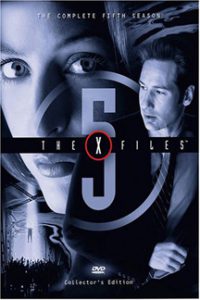“The X-Files” fifth season (1997-98, Fox) is one big appetizer for the main course — “X-Files: Fight the Future,” which would hit movie theaters in the summer of 1998 and presumably give epic answers to those nagging mythology questions.
Indeed, Season 5 offers a lot to nibble on, but it’s not a satisfying meal in its own right. David Duchovny and Gillian Anderson, presumably a bit burned out after shooting the movie in the summer of ’97, hand off the ball a lot this season (“Unusual Suspects” and “Travelers” flash back to other characters and don’t include Scully at all, and Mulder takes off most of “Christmas Carol” and “Chinga”).
Even the writing staff brings in sci-fi greats Stephen King and William Gibson for an episode apiece.

“The X-Files” Season 5 (1997-98)
Fox, 20 episodes
Showrunner: Chris Carter
Starring: David Duchovny, Gillian Anderson, Mitch Pileggi
And while some mythology developments were interesting at the time — Mulder believes all alien stories were invented by the government, and Scully discovers she has a daughter — they were ultimately detours from the primary thread of the mythology.
The most unnecessary side trip was the notion that the Cigarette-Smoking Man was dead. He wasn’t, and he came back to resume his old job without much incident (other than killing one of the guys sent to retrieve him).
On this viewing of the DVDs, I was surprised by how experimental Season 5 is. I had remembered Season 6 is being the year when “The X-Files” really went outside the box, but Season 5 is rife with such episodes; only about five of the 20 episodes are old-fashioned monster-of-the-weeks.
Season 5 marks the beginning of a gradual downward slide for the show, in the sense that it will never again be as good as Seasons 3 and 4 (however, I don’t believe Seasons 6 through 9 are as bad as their reputation). It’s also the last year the show filmed in Vancouver (the first movie and the last four seasons were filmed in Los Angeles, although the second movie returned to Vancouver).
It’s also worth noting that Chris Carter had originally planned for the show to last five years.
So when we arrive at the last episode, “The End,” it does indeed feel like the end of an era, even though we knew even then that “The X-Files” would be back in the fall (the Syndicate-centered mythology arc would be wrapped up in mid-Season 6, and then a fresh mythology arc would begin).
Season 5 stands as a respectable, albeit hard-to-pin-down, final year of the Vancouver era. But like I say, many episodes whetted my appetite for rewatching “Fight the Future.”
Here are my Season 5 episode rankings:
1. “Unusual Suspects” (episode 1, written by Vince Gilligan)
This episode aired in 1997 and “The Lone Gunmen” premiered in 2001, yet this is essentially a pilot episode for that series, as we go back to 1989 and learn how the Gunmen got together. We also learn how Mulder’s belief in government conspiracies got started. (He was interested in alien abduction since he saw his sister get abducted when he was a kid, but he never really suspected government involvement until the events of this episode.)
2. “Bad Blood” (12, Gilligan)
Many fans rank this as their favorite episode of the entire series, and I can’t blame them. It starts with Mulder staking a human who he thinks is a vampire, and saying “Oh, sh–” just as the opening credits kick in.
But rather than a lot of silliness, the episode ends up being a spot-on examination of the phenomenon of point-of-view; we see the events from Scully’s perspective, with all of her biases (Mulder is always calling on her to do autopsies, and the sheriff — played by Luke Wilson — is pretty good looking), then from Mulder’s perspective, with all of his biases (Scully is whiny about his autopsy requests, and the sheriff has buck teeth).
3. “Kill Switch” (11, William Gibson and Tom Maddox)
The idea of a satellite weapon with pinpoint targeting capability was scary when guest writers William Gibson and Tom Maddox wrote this, and it still is 13 years later.
The episode, featuring the eye-black-sporting computer genius Invisigoth (Kristin Lehman) — on whom the Lone Gunmen develop a crush — boasts Gibson’s cyberpunk trappings (including a killer virtual reality device, something he would revisit in Season 7’s less-respected “First Person Shooter”) but still feels like an X-File. This is the only time in Season 5 when it feels like “The X-Files” is doing a totally fresh MOTW story.
4. “The End” (20, Chris Carter)
It has big mythology moments: the Syndicate taps the CSM for help again, the CSM tells Agent Spender he’s his father, a young boy named Gibson Praise might have the brainpower to explain all paranormal phenomenon, and Mulder’s office goes up in flames (leaving a noticeable whiff of Morleys behind).
But I like “The End” for the cute Mulder-Scully stuff that comes via Gibson reading the agents’ minds and Scully being threatened (though she’d never admit it) by the presence of Mulder’s old flame Diana Fowley (Mimi Rogers). There’s a scene where Scully, having seen Mulder and Fowley talking in private, retreats to her car to call Mulder back to the office; I was thinking (in a playground sing-song voice) “Scully loves Mulder, Scully loves Mulder.”
5 and 6. “Redux” and “Redux II” (2, Carter, and 3, Carter)
Influenced by a compelling tale from government agent Michael Kritschgau and his trip to find a supposed alien corpse in the Yukon, Mulder does a 180 and comes to believe that all stories of aliens were planted by the government. With a tip from the CSM, he returns the chip to Scully’s neck, thus curing her cancer. It’s refreshing to have Scully healthy again at the end of this epic trilogy (which started with the Season 4 finale, “Gethsemane”).
7 and 8. “Patient X” and “The Red and the Black” (13, Carter and Frank Spotnitz, and 14, Carter and Spotnitz)
At this point, Mulder still staunchly believes that aliens are a government creation, so this ends up being a classic flip-the-script episode when Scully is present for not only the alien abduction of Cassandra Spender, but also the murders of many chip-implanted innocents by torch-wielding killers with no facial features.
The faceless aliens are rivals of the grays, with whom the Syndicate is in league. But not entirely in league: The Well-Manicured Man wants to hold onto a faceless alien captive as a bargaining chip and also see if a cure for the black oil will work on the unfortunate Marita Covarrubias, who had backstabbed poor Alex Krycek.
Also, we meet Agent Spender, who we immediately suspect will be the son of the CSM since he is played by Chris Owens, who played the young CSM in Season 4’s “Musings of a Cigarette-Smoking Man.” Whew! Up to this point, there hasn’t been a more information-packed mythology two-parter, and for the most part, I was able to follow along.
9 and 10. “Christmas Carol” and “Emily” (5, Gilligan, John Shiban and Spotnitz, and 7, Gilligan, Shiban and Spotnitz)
This is a Gillian Anderson acting showcase as she becomes attached to an orphaned girl named Emily and then finds out that she is her mother. Emily, who came into being so the Conspiracy could experiment on her (or something like that), dies in the end, but she will stay in Scully’s thoughts and prayers. This two-parter is more of a diversion than crucial mythology viewing, but it works.
11. “Chinga” (10, Carter and Stephen King)
It’s co-written by Stephen King, but the best part of this episode is what I presume to be Chris Carter’s contribution: the asides showing Mulder, who — like a rowdy kid — is dribbling his basketball in his living room and throwing pencils at the ceiling in impatience while Scully is on vacation.
The other half of the joke is that Scully doesn’t end up getting a true vacation experience in Maine (other than one bubble bath), because the local sheriff keeps asking for her help in the case of a killer kid and/or killer doll. We see that Mulder and Scully are both doomed to never be able to relax, but for different reasons.
12. “Travelers” (15, Shiban and Spotnitz)
“Travelers” flashes back to 1990, when Mulder, merely an FBI profiler at the time, interviews former agent Arthur Dales (Darren McGavin) about an alleged communist who turned out to be a monster. Most of the episode shows the case unfolding during the McCarthyism era, but “Travelers” is fondly remembered for its framing device featuring voice-overs by McGavin, whose presence brought full-circle the connection between “Kolchak: The Night Stalker” and its superior, but indebted, progeny.
13. “Folie a Deux” (19, Gilligan)
It starts off as a standard crazy-hostage-taker yarn until Mulder realizes, like in Season 2’s “Duane Barry,” that the guy isn’t crazy: His boss truly is a monster, and many of his co-workers actually are zombies.
Due to the monster, I had remembered this as a ripoff of the “Buffy” episode “Teacher’s Pet,” but on this viewing I realized that it is an important episode for establishing where these characters are at this point. Mulder is back in believer mode, and Scully still plays the skeptic, but — as indicated when she finally sees the monster — she has come a long way since the series started.
14. “Detour” (4, Spotnitz)
This is a second-rate attempt to duplicate Season 3’s “Quagmire,” as Mulder and Scully get stranded in the Florida forest at night. Still, I do love Scully’s flirty line about how maybe it will start raining sleeping bags and he’ll get lucky.
15. “The Pine Bluff Variant” (18, Shiban)
“The X-Files” shows its versatility as Mulder goes undercover, and gets his pinky broken in an interrogation, in an episode that plays more like a Jack Bauer mission on “24.” Of course, it is rich with the government conspiracy (here, the U.S. is secretly developing a chemical weapon) that paints it as an “X-Files” episode.
16. “All Souls” (17, Billy Brown, Dan Angel, Spotnitz and Shiban)
This is one of those flip-the-script religion-themed episodes. Scully plays the believer and other characters (even her priest!) are skeptical that she’s seeing a spooky angel come down to claim the souls of handicapped quadruplets. It serves as a coda for Scully’s all-too-brief experience as Emily’s mother.
17. “Schizogeny” (9, Jessica Scott and Mike Wollaeger)
It has strong performances by two teen actors and creepy orchard cinematography; also, I don’t mind the story about a psychologist going too far in telling her patients to fight back against their oppressors. Yet Duchovny and Anderson don’t seem fully engaged here, so the episode falls flat.
18. “Mind’s Eye” (16, Tim Minear)
Lili Taylor gives a much-praised performance as a blind girl who is arrested for murder. Like in Season 3’s “Oubliette,” Mulder is the only one who believes she is innocent, and the whole episode is about his struggle to get her to tell the truth. It’s a solid episode, but it ranks low on my list because there’s not much mystery about where the plot is going.
19. “Kitsunegari” (8, Gilligan and Minear)
I’m not a big fan of Season 3’s beloved “Pusher,” and this sequel — Pusher escapes from prison, but (inexplicably) it’s just to tell his twin sister with identical mind-control powers to stop killing — is a step down from that.
20. “The Post-Modern Prometheus” (6, Carter)
Some people rank this as their very favorite episode of the series. It has some elements that have made other episodes great — the use of old pop standards as in-scene music, the exploration of a misunderstood monster — and it stands out as the only episode shot in black and white.
Also, it opens as a comic book cover and closes as a final comic-book panel, so style points abound. But I have to be honest: It doesn’t come together into a satisfying finished product.
How would you rank the episodes in the fifth season of “The X-Files?”


